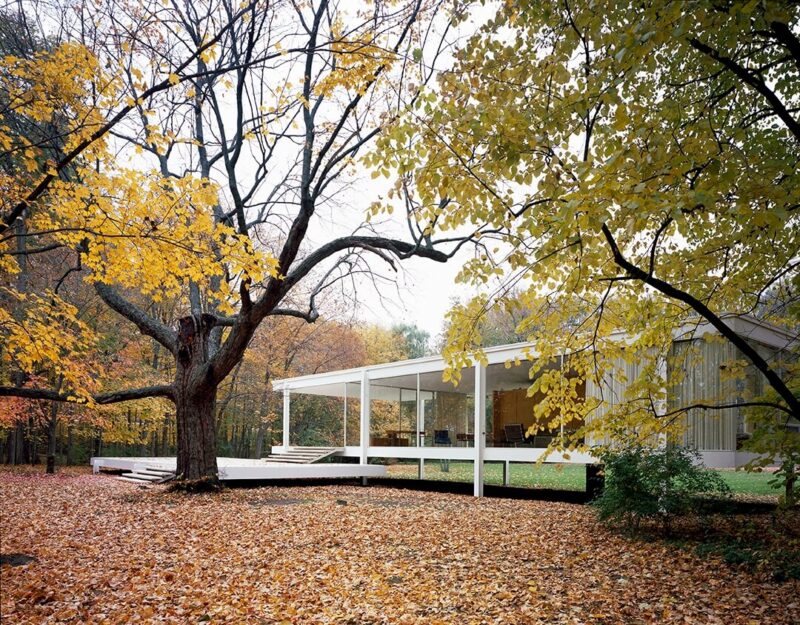Ask a fan of modern architecture to cite a few of the most celebrated residential landmarks of International Style design in the US, and many will name the Edith Farnsworth House high on their lists.
Edith Farnsworth commissioned Ludwig Mies van der Rohe to design and build the home on a flood plain in Plano, Illinois. It was designed and built between 1945 and 1951.
The house owes its fame both to its beautiful design and the controversy that surrounded the project during its construction. But as you will discover, its critics at the time did not seem to grasp the philosophy behind its architecture.
A Fraught Project with a Legendary Result

The controversy concerning the Edith Farnsworth House was financial—at least to start. Basically, speculation at the time was driving up the costs of commodities. While Edith Farnsworth approved an initial budget of $58,400, the final cost came in at $74,000. At the time, the $15,600 difference was equivalent to $173,972 in 2022 dollars.
When Farnsworth refused to pay $28,173 of the cost, Mies sued her. She then counter-sued for malpractice. While the court decided in Mies’ favor, the case generated a lot of negative publicity, and his former employee, architect William Dunlap, had to finish up work on the home.
It does seem the conflict may have concerned more than commodities. In Women and the making of the modern house: a social and architectural history, Alice T. Friedman writes, “[t]here is no evidence to suggest that [Farnsworth] sought to have her behavior challenged by the ‘inner logic’ of Mies’s unyielding architectural vision; on the contrary, she seems to have had a clear idea about how she wanted to live and she expected the architect to respect her views… [S]he soon discovered that what Mies wanted, and what he had thought he had found in her, was a patron who would put her budget and her needs aside in favor of his own goals and dreams as an architect.”
When the court case brought the house to broad public attention, critics of the International Style suggested a communist agenda by Mies and other modern architects.
Mies Understood the Plight of the Individual in Industrial Times

To understand what Mies did seek to achieve through the Farnsworth House’s disruptive modern design, it is best to turn to the words of the man himself.
In his essay “Architecture and the Times,” Mies wrote, “Architecture is the will of the epoch translated into space … The demand of our time for realism and functionalism must be met.” He continued, “We are concerned today with questions of a general nature. The individual is losing significance; his destiny is no longer what interests us.” He added, “Our utilitarian buildings can become worthy of the name of architecture only if they truly interpret their time by their perfect functional expression.”
In short, Mies did not want to resist moving forward with the times. He embraced industrial materials like glass, concrete and steel. But he did recognize the very coldness of the era that his critics so often seemed to perceive in his work. The irony is that Mies was, in his own particular way, attempting to ward off that very coldness. The destiny of the individual did concern him.
How the Edith Farnsworth House Made Room for the Individual

In the Edith Farnsworth House, Mies made space for the modern individual in the most literal way. While blocks inside the home help break up that space into zones, there are no walls dividing the room completely. Views are unobstructed, and movement is unencumbered. The individual can move through life within their home as they see fit, even if their movements outside it are constrained by how they must fit into their industrial society.

Mies was also deeply aware of how industrial life cut off human beings from nature. He once said, “We should attempt to bring nature, houses, and the human being to a higher unity.” He certainly achieved that with the Edith Farnsworth House. The above photo of the interior looking out shows the trees surrounding the home through the floor to ceiling glass, where it feels as if there is almost no boundary between the interior and exterior.
Critics of the home in its time seem almost shockingly ignorant of what Mies was doing. Both the open, flexible interior of the Edith Farnsworth House and its connection to nature show a deep warmth and empathy for the individual. Mies’ choice of materials and the surface austerity of his designs are deliberately industrial in nature. But he used both in a subversive way, building homes and offices that set their occupants free of rigid industrial demands.
Learn more about Ludwig Mies van der Rohe, his famous Barcelona Chair, and his undersung collaborator Lilly Reich. and the . You may also be intrigued by the International Style in general and the Glass House by Philip Johnson, which shares a similar style. And of course, don’t forget to follow us on Instagram, Facebook, Pinterest and YouTube for more Atomic Ranch articles, house tours, and ideas!












